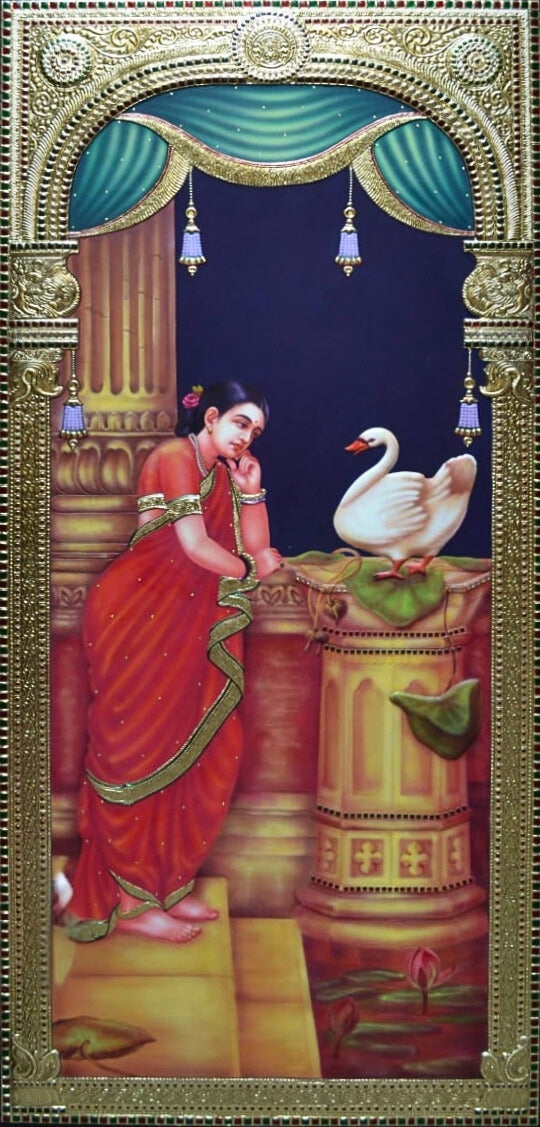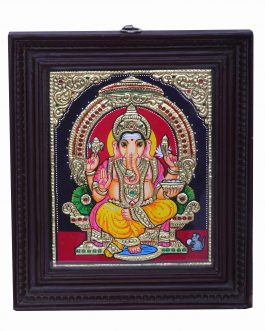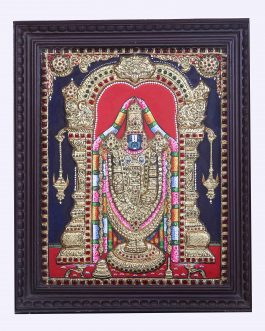Introduction:
Located on Tamil Nadu’s eastern coast lies the city of Thanjavur, often referred to as the Rice Bowl of the state. The city is well-known for its rich cultural legacy, which includes meticulously crafted sculptures, historic buildings, and distinct forms of art. Among them, the Thanjavur painting is one of the most well-known art forms that dates back to the 16th century and continues to be a popular art form in the state even today. The city, which was the centre of the Chola kingdom and a flourishing capital, was later conquered by the Pandyas, the Vijayanagar Empire, the Nayakas, and others. In 1676, Ekoji founded the Maratha kingdom. Eventually, the Maratha rule in the area continued for over a century. This period, according to scholars and historians, was the start of the cultural revival of the region.

Source: Wikipedia. Picture of Ancient Thanjavur
Thanjavur painting: origin and development:
Historically, multiple theories trace the roots of Thanjavur paintings. The most generally accepted theory among them says they originated most probably in present-day Andhra Pradesh. During the 17th century, due to political turmoil in the Deccan region, Deccan artists migrated towards Tamil Nadu and Mysore. There, the artists received patronage from Mummadi Krishnaraja Wodeyar of Mysore and the Thanjavur ruling clan. And under the Bhonsle dynasty, this genre of painting took a more organised and unique direction and continues to thrive till now.
The use of gold, which is usually applied to an embossed portion of the canvas, is one of the most special and different technical aspects of Tanjore art. It gives the paintings a solid foundation while also ensuring that it provides the radiant base required. Precious stones like Swarovski crystals and Kundan stones are frequently used on them, giving the artwork more beauty and thoroughness. It also appears that the overuse of gold in these entirely handcrafted paintings is intended to evoke a sense of devotion. On the whole, as a result of the presence of gold, the shine of these paintings lasts for over a century, considering pure gold never fades.

Gold embossed Thanjavur painting. Source: Indiamart
Growth and change:
Paintings usually derive their inspiration from classical dance, music and literature. The themes of the art included Hindu deities, figures, birds, flowers, animals and saints. In addition to this, the art form took a completely different turn under the patronage of the Maratha Bhosle dynasty, and further against the increased influence of the colonial period, a cosmopolitan openness also emerged, with Christian themes such as the ‘Madonna and Child’, painted in Tanjore style for colonial patrons. What is interesting to note is that the adaptability without the loss of devotion helped the art form to reach both religious and secular audiences. Despite the colonial interference in the 19th century. The Thanjavur paintings clearly were not something reproductive or conservative but rather ran artform flexible enough to accommodated as well as retained the original characteristics.

An 1815 Thanjavur painting influenced by colonial art. Source: Map academy

Thanjavur painting, inspired by classical Tamil literature, Lady with a Swan. Source: Me meraki
Technique:
For traditional artists, technique isn’t just a list of steps but a discipline. From preparing the wooden base to adding the gold foil, each part of the process has cultural and symbolic importance. These steps follow methods that have been used for hundreds of years. The main figure, typically a deity positioned in a particular symmetrical alignment and enclosed in a decorative frame, is always painted at the centre of the painting and is believed to be unique to Tanjore paintings. In these paintings, colour plays a significant role. For instance, red denotes passion and energy, green fertility and harmony, and blue spiritual depth and detachment. To maintain the authenticity of the images, the artists carefully stick to the traditional colours of each deity.
The Gesso piece, which gives Tanjore paintings their distinctive three-dimensional appearance, is one of their most well-known characteristics. Gesso wasn’t usually used in artistic works during the time it was first used in Thanjavur paintings; instead, it was used to create elements like columns in the British territories. This indicated the innovative and creative mind of the regional artists.

Gesso Thanjavur painting. Source: Mangala Paintings
Motifs
Traditional themes frequently seen in this painting style include the mythical yazhi, which is thought to protect temples, and gilded temple arches with floral designs. Some of the frequent figures in these works of art date back to the 16th century. As shown in the image, Yazhi has a serpent’s tail, a lion’s head, and elephant-like tusks. Whereas representations of Lord Durga usually feature more floral elements and paintings of Ganesha frequently feature a circular motif set with stones. Lotus is one of the most important floral motifs, which is painted below the deity in different images, and is believed to show the spiritual awakening and signify the purity of the paintings. The motifs involved in the Thanjavur paintings are filled with gold embellishments and vibrant colour palettes. For example, the Kaasu malai motif [ The coin necklace] is associated with grace, lavishness and abundance. Similarly, the golden mandapa-like structure against the background of the central figure is another important symbol of the painting. The pillar in the backdrop of the paintings is usually adorned with celestial beings, floral patterns and intricate designs that are found on the Dravidian temple architecture. This motif, flanked by pillars, is generally believed to portray the sanctity of the art, giving it a divine outlook. Apart from that, a series of cultural adaptations and assimilation of the art led to Mughal miniature influence and the narratives like panchachitra also decorating the paintings, giving a new perspective to the art. On the whole, very motif is detailed carefully and are covered in multiple layers that are open to the interpretation of the audience.
Image of Yazhi. Source ;wikipedia

painting of lord Ganesha. source: Poompuhar paintings

The motif of Kaasu malai. Source: Poompuhar paintings
Current status:
Although the number of artists producing these paintings has steadily decreased over time, numerous organisations, including state governments, continue to preserve the tradition by holding workshops, training sessions, exhibitions, and revival programs centred around Thanjavur painting. On a positive note, Tanjore Painting was recognised as a Geographical Indication by the Indian government in 2007–2008, although some materials have been replaced due to changing times [The replacement of a jackfruit canvas with a plywood or teak wood]. Most importantly and above all, the painting remains relevant because of the local artist community’s firm commitment to preserving art; it is what keeps it alive and thriving.

Process of creating a Thanjavur painting. Source: Artisera
Conclusion
In conclusion, the art form, rather than being an independent genre, is a product of perpetual patronage and practices of multiple kingdoms. The Thanjavur paintings of today have withstood multiple changes over the years and thus have become a representation of determination, resilience, and adaptability. Nonetheless, art is nothing without the artists’ commitment to their craft. It has huge cultural significance and has a firm place in Tamil Nadu’s history and culture. Thanjavur paintings continue to hold a special place in present society due to the artists’ constant commitment to maintaining the sacredness of the art and their refusal to give up their cultural heritage and legacy.
Every painting on the canvas tells a story that not only represents the history, culture and tradition of the state and the city but also tells a story of the depth, dedication and effort of the artist.

An iconic Thanjavur painting embossed in golden foil. Image: Pinterest
References
Journal https://www.jetir.org/papers/JETIR2008241.pdf%20citation
Popuri, Kavya, and Srishti Srivastava. Recreating Traditional Tanjavur Arts and Crafts in Interior Design.
https://www.exoticindiaart.com/article/tanjore-art-south-india/
Yadav, Damini, and Prof. Nirupama Singh. Manifestation of Traditional Techniques and Material Adaptations in Indian Contemporary Tanjore Painting.
https://www.ijfmr.com/papers/2025/3/47582.pdf
https://www.superprof.co.in/blog/tanjore-painting/
Tanjore Art – A Divine Legacy of Gold in South India’s Cradle of Arts. Article of the Month, Sept. 2021
https://www.exoticindiaart.com/article/tanjore-art-south-india/




